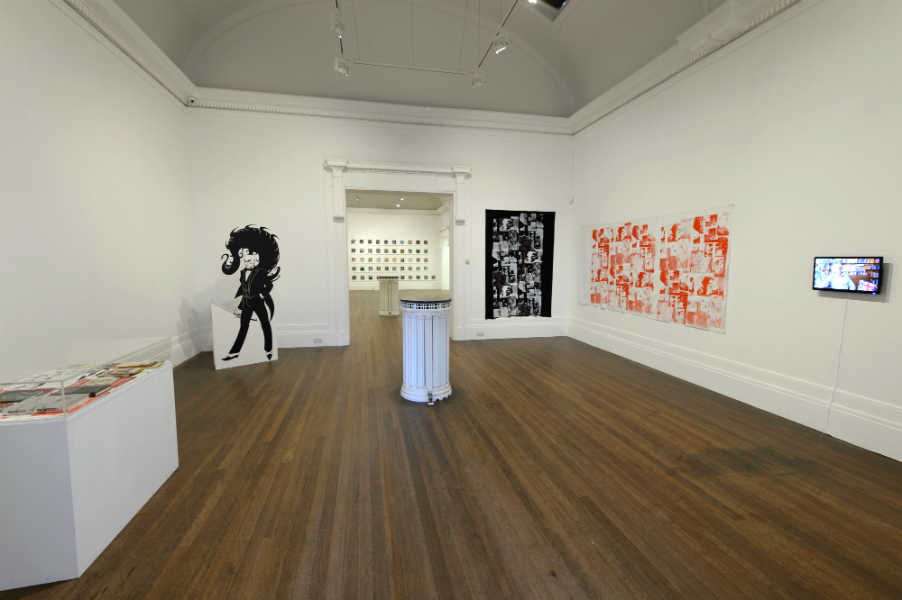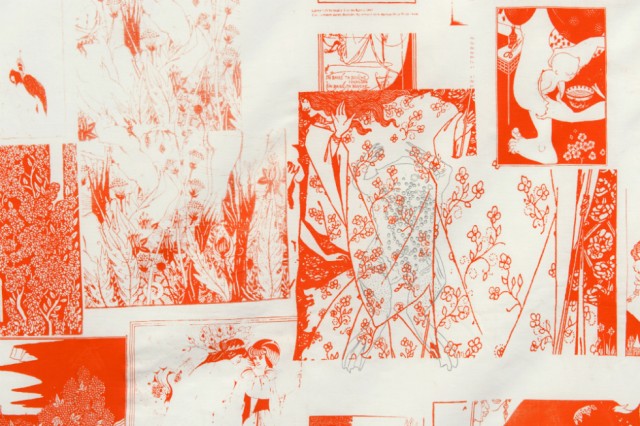Assassination, Space Travel & Regeneration: Modern History Vol. 1 — Reviewed

Lara Eggleton comes face to face with the unprecedented contradictions of our age at the Grundy gallery’s latest exhibition…
Modern History Vol. 1, guest curated by Lynda Morris and organised by Sophia Crilly and Richard Parry, opens with a series of historic events immortalised in news reporting. Two framed front pages of the Daily Express, discovered in a Blackpool charity shop, announce the first moon landing and the assassination of President John F. Kennedy. The still shocking video footage of Donald Campbell’s fatal crash on Coniston Water as he attempted to break the world speed record in his hydroplane ‘Bluebird K7’, audibly loops in the gallery foyer. Hubristic tragedy meets the society of the spectacle – cue the Modern Era. What these mediated events have in common is the way in which they are embedded in our collective memory, and how their (pardon the anachronism) viral spread signalled a new horizon of history making.
The subsequent rooms of the Grundy are home to contributions by 14 different artists and collectives, requiring varying levels of dedication. They invite the viewer to jump between people, places and events roughly spanning the years between 1969 and the present day, an accelerated period of history that has left us with a series of ‘posts’ by way of description (Postwar, postmodernity, postindustrial, poststructural, etc.). This is distinct from the earlier phase of Modernity with its origins in the late 18th century.
Pavel Büchler’s A Modern History is a nod to this longer history, a vitrine containing a 1970s copy of Alan Palmer’s Penguin Dictionary of Modern History, 1789-1942, with a single sheet printed with the letter ‘H’ bookmarking the entry on Hegel. We are the heirs of Modernity’s dark legacies: industrialism, colonialism, consumer capitalism, global surveillance, fossil fuel mining, and the increasingly sophisticated technologies that facilitate them.
Morris, with the support of Contemporary Visual Arts Network (CVAN), has used the North West of England as a geographic lens through which to view these seismic cultural shifts. All artists are based in the region, at different stages of their careers. Some works require more background information than others, and it seems a disservice to them that the materials accompanying the exhibition (including a cumbersome ring-binder catalogue), are far from comprehensive. The curator’s introductory text adds yet further associations to this dense ensemble, from the events of 9/11 to Charlie Hebdo, along with references to projects and artists not included in the exhibition.

Nevertheless, a good dig reaps its rewards. The catalogue gives further insight into the esoteric design sensibility of the Savoy publishers, explored by The Exhibition Centre for the Life and Use of Books (ECLUB: Robert Carter, Daniel Fogarty, and Lauren Velvick). The reason for Aubrey Beardsley’s salacious nineteenth-century illustrations appearing in their brightly printed textiles suddenly becomes clear. Like Beardsley’s provocative drawings, Savoy’s founders David Britton and Michael Butterworth flirted with the conservatism of the 1970s and 80s through their use of taboo iconography (most notably in the overt nod to the Holocaust through the antihero ‘Lord Horror’, displayed in cardboard cutout). ECLUB cleverly combines these subversions – Victorian and Postwar – through the reproduction and repetition of Savoy motifs.
If Modern History vol. 1 contains some dense patches, they serve to make less content-laden works worth savouring. Picasso’s Dove is a compositional marvel, a feathery white roundness punctuating a charcoal background. The fact that it was created for the World Peace Conference held in Sheffield in 1950 (the only time the artist ever visited Britain) is an interesting if slightly tenuous reason for its inclusion. Gary Wiggins’ delicately detailed drawings of Staffordshire bull terriers are similarly seductive; their muscled forms are stripped of all threat as they float weightlessly in large paper voids. Their suspended isolation frees them from associations with gang violence and dog fighting, asking us to see them as the vulnerable creatures they are.

Moving through the generous rooms of the Grundy I was pleased to find my confusion dissolving into curiosity – I wanted to know more. As an art historian this is a familiar, reassuring moment when in amongst the clamour of facts and details something starts to take shape. From the chaos of history a strange kind of logic emerges, giving meaning to particular moments and making connections across time and space. As stated in the exhibition guide, artists have the ability to ‘display insight’ in such a way that cuts through the noise of mainstream media and everyday life. Modern History vol. 1 reminds us that contemporary art has the potential to awaken our dulled senses, to bring focus and clarity to the complexity around us.
In these troubled times artists are often the last bastion for salvaging and commemorating the past, whilst shedding a critical light on the present. Susan Walsh’s elegiac video of the demolition of a Preston housing estate (Home/Territory) is a memorial to an era that forgets itself with each new regeneration project, and prioritises corporate profit over human needs. Her work has parallels with Jen Wu’s The [Salford] Wall project, explored through a dual video that shows her attempts to reconstruct Salford’s Old Bank Theatre as a grassroots initiative, brick by numbered brick. Originally built in the 1930s by the Royal Liver Friendly Society as a symbol of working class solidarity, it was demolished in 2014. In May 2015 Wu obtained permission from English Cities Fund to retain the finished wall as a permanent monument on Chapel Street.
Modern History Vol. 1 asks us to reflect on the different ways history can be defined: is it marked by landmark events or happenings, interpreted by global media, or is it given meaning through the individual charting of place and time? How many histories lay just below the surface, waiting to be unearthed? The exhibition offers hidden, overlooked and discordant narratives that bring us face to face with the unprecedented contradictions of our age. It is a sobering yet surprisingly playful experience – see it while it lasts.
Lara Eggleton, art writer and historian
See Modern History Vol. 1 at the Grundy Gallery, Blackpool, until Saturday 13 June 2015, free entry
The exhibition series will continue with Modern History Vol. 2, 18 August-8 November 2015, at The Atkinson, Southport, and Modern History Vol. 3, 19 September-21 November 2015, at Bury Art Museum & Sculpture Centre. Follow on Twitter: @ModernHistory_
This article has been commissioned by the Contemporary Visual Arts Network North West (CVAN NW), as part of a regional critical writing development programme funded by Arts Council England — see more here #writecritical
Read Hostages, Apollo & The General Election: Modern History Vol. II — Reviewed





